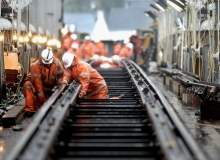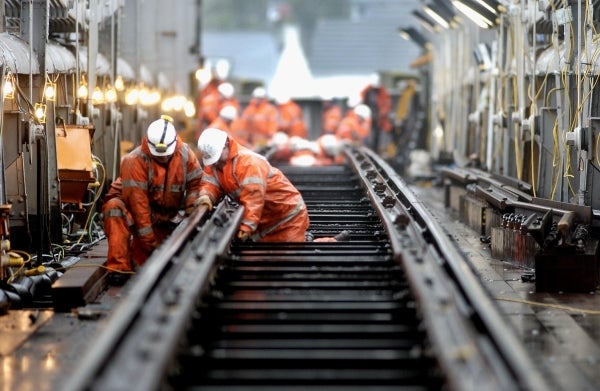

Travelling by rail is already one of the most sustainable ways to travel. Indeed, in the UK trains contribute only 1.8% of greenhouse gas emissions relating to domestic travel, compared to the more than 90% generated by road vehicles.

Discover B2B Marketing That Performs
Combine business intelligence and editorial excellence to reach engaged professionals across 36 leading media platforms.
But greenhouse gas emissions are only one aspect of what makes a company – and an industry – truly sustainable.
An effective sustainable development strategy needs to take into account everything from community impact to safety and wellbeing, along with employee engagement and protection of the natural environment.
True sustainable development is far from an exact science, with each separate strand – whether it’s safety, passenger experience or local environmental issues – directly related to the strands that surround it.
This is precisely what Network Rail has realised and started to implement with its new sustainable development strategy, christened ‘A railway fit for the future’.

US Tariffs are shifting - will you react or anticipate?
Don’t let policy changes catch you off guard. Stay proactive with real-time data and expert analysis.
By GlobalDataThe strategy takes into account safety and wellbeing, communities, accessibility and inclusivity, employees, energy, resources, environmental protection, climate change adaptation, buildings and land, while also recognising the interdependencies between these different aspects of the organisation and their impact on the wider rail sector and the UK economy.
However, the 2013-2024 strategy, which is currently only months old, certainly doesn’t tick all the boxes and has already received criticism for asking more questions than it offers answers or measurable targets. We met the company’s head of sustainable business strategy Ian Groark to find out whether the plan is ambitious enough.
Elly Earls: Why did Network Rail decide to launch its new sustainable development strategy this year?
Ian Groark: The strategy covers a variety of topics – from health and safety to the environment through to diversity and inclusion, accessibility, local community impact and relations, and also the big global macro-economic impact.
We’re about ten years old as a company and these issues have all been managed to a greater or lesser extent across the ten-year period, but never really in a strategic way.
Now the business is becoming more mature, we want to manage those in a more strategic way.
This is the first time we’ve pooled these elements together and began to look at – and I stress the word ‘began’ – how to get better at managing these in the long term as we move ten, 20 or 50 years into the future from now.
Moreover, while safety has always been absolutely the priority issue, alongside that, we’ve recognised the increasing interdependencies between safety, passenger experience and so on.
For example, how do you manage local environmental issues in a way which maintains safety and punctuality?
EE: The strategy runs from 2013-2024, but will you be taking a longer-term view than this ultimately?
IG: Yes, we will. We need to make sure what we’re doing today is fit for purpose 50 years from now, not just ten years from where the company began. This strategy is only the first step.
We could have taken an ultra-cautious approach and waited until the world was perfect to publish it, but that probably wouldn’t have been until 2024! So we decided as a business that that wasn’t the right thing to do.
There are expectations on us to show our regulators, our owners and our key stakeholders what we intend to do in this area and, therefore, we’ve pulled a strategy together, which is our first step.
EE: The strategy has received criticism for not being ambitious enough or setting enough measurable targets. Do you think this is fair?
IG: We have had some criticism that there are more questions than answers in some instances, but we’ve put on paper what we think we should be focusing on, what issues we think are important to our stakeholders and to the business and, as far as we can, why.
What we want to do next is actually fill the meat around those bones and provide the real content of where we want to get to on these issues and what’s the right level of performance.
And that will take us a little while to do.
I think to take a bigger bite would have been difficult for our shareholders and board to accept. So we started off with something that is palatable – albeit high-level – and which provides the impetus for us to develop further.
EE: What can we expect next from the strategy and what challenges will you face setting more measurable targets in the future?
IG: There’ll be a process of continually reviewing and improving the strategy. One of the agreements we’re likely to have with our regulators is that we need to develop a really comprehensive suite of sustainable development indicators that would help us articulate how we’re meeting our stakeholders’ expectations in these areas over the coming period.
But that’s got to be tempered with a robust rationale. So we want to do this rapidly, but spend the time to work with those stakeholders who have got a real interest in the rail industry and Network Rail’s sustainable development credentials, understanding with them what our level of ambition should be for the different aspects of sustainable development relevant to our business.
Then we can translate that level of ambition into meaningful, measurable targets for the next five, ten years, up to maybe as far as 2050, rather than rushing. We’ll spend the time that’s needed to get the right target, from a stakeholder point of view and a commercial point of view.
EE: Finally, Network Rail is a large, geographically spread organisation, with great influence over both the wider rail sector and the UK economy. Are you hoping that this strategy will set a precedent for both in terms of sustainability?
IG: We’d certainly like to guide sustainable development impacts that are outside of our direct control, by either working through our supply chain or with our train operating and freight operating customers – either through a contract or an operating procedure or an agreement.
More widely, we can influence other aspects that are further outside our direct control through being members of industry bodies and local organisations.
For example, we can use our investment in rail or the government’s investment in rail to regenerate particular geographic locations in a particular town or city. We’ve definitely been thinking about what our role is as part of the rail industry and as part of UK society.
Of course, we’ll take it one step at a time – you’ve got to manage your own home first. But when it comes to the wider guiding of the industry and influencing the economic and social development of the UK, we’re an integral part of that fabric.
Related content
Saving energy to create sustainable subways
Research has shown that saving just five percent of energy in a subway station is equivalent to the amount of energy used by 700 households in a year.
Resistance is futile: how aerodynamics inform train design
Advanced aerodynamic design is a decisive factor in improving the energy efficiency of locomotives and rolling stock.





